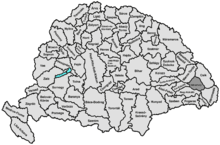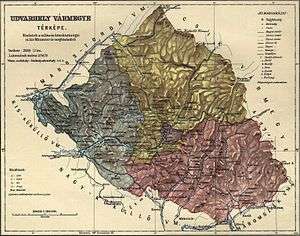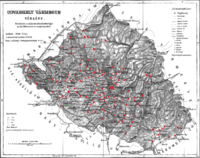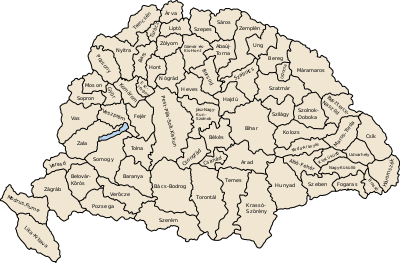Udvarhely County
Udvarhely (German: Oderhellen) was an administrative county (comitatus) of the Kingdom of Hungary. Its territory is now in central Romania (eastern Transylvania). The capital of the county was Székelyudvarhely (now Odorheiu Secuiesc).
| Udvarhely County | |
|---|---|
| County of the Kingdom of Hungary (1876-1920, 1940-1945) | |
 Coat of arms
| |
 | |
| Capital | Székelyudvarhely |
| Area | |
| • Coordinates | 46°18′N 25°18′E |
• 1910 | 2,938 km2 (1,134 sq mi) |
| Population | |
• 1910 | 124173 |
| History | |
• Established | 1876 |
• Treaty of Trianon | 4 June 1920 |
• County recreated (Second Vienna Award) | 30 August 1940 |
• Disestablished | 1945 |
| Today part of | |
| Odorheiu Secuiesc is the current name of the capital. | |

Geography
Udvarhely county shared borders with the counties of Maros-Torda, Csík, Háromszék, Nagy-Küküllő, and Kis-Küküllő. The county lay in the Carpathian Mountains. Its area was 2938 km² around 1910.
History
The Udvarhely region was a settlement (seat) of the Székely, Udvarhelyszék. Udvarhely county was formed in 1876, when the administrative structure of Transylvania was changed. In 1920 by the Treaty of Trianon the county became part of Romania until 1940 when by the Second Vienna Award much of its territory was reassigned to Hungary. After the end of World War II it became again part of Romania. Its territory constitutes now the present Romanian counties Harghita, Mureș (a small part in the west) and Covasna (a small part in the south-east).
Demographics
In 1900, the county had a population of 118,275 people and was composed of the following linguistic communities:[1]
Total:
- Hungarian: 112,607 (95.2%)
- Romanian: 2,928 (2.5%)
- German: 2,225 (1.9%)
- Slovak: 19 (0.0%)
- Ruthenian: 3 (0.0%)
- Serbian: 3 (0.0%)
- Croatian: 2 (0.0%)
- Other or unknown: 488 (0.4%)
According to the census of 1900, the county was composed of the following religious communities:[2]
Total:
- Roman Catholic: 41,893 (35.4%)
- Calvinist: 40,237 (34.0%)
- Unitarian: 26,614 (22.5%)
- Eastern Orthodox: 4,101 (3.5%)
- Lutheran: 2,830 (2.4%)
- Greek Catholic: 1,387 (1.2%)
- Jewish: 1,204 (1.0%)
- Other or unknown: 9 (0.0%)

In 1910, the county had a population of 124,173 people and was composed of the following linguistic communities:[3]
Total:
- Hungarian: 118,458 (95.4%)
- Romanian: 2,840 (2.29%)
- German: 2,202 (1.77%)
- Serbian: 35 (0.03%)
- Slovak: 33 (0.03%)
- Croatian: 5 (0.0%)
- Ruthenian: 1 (0.0%)
- Other or unknown: 599 (0.48%)
According to the census of 1910, the county was composed of the following religious communities:[4]
Total:
- Roman Catholic: 45,116 (36.33%)
- Calvinist: 41,632 (33.53%)
- Unitarian: 27,567 (22.2%)
- Eastern Orthodox: 4,020 (3.24%)
- Lutheran: 2,991 (2.41%)
- Greek Catholic: 1,508 (1.21%)
- Jewish: 1,313 (1.06%)
- Other or unknown: 26 (0.02%)
Subdivisions
In the early 20th century, the subdivisions of Udvarhely county were:
| Districts (járás) | |
|---|---|
| District | Capital |
| Homoród | Oklánd, RO Ocland |
| Parajd | Parajd, RO Praid |
| Székelykeresztúr | Székelykeresztúr, RO Cristuru Secuiesc |
| Udvarhely | Székelyudvarhely, RO Odorheiu Secuiesc |
| Urban districts (rendezett tanácsú város) | |
| Székelyudvarhely, RO Odorheiu Secuiesc | |
References
- "KlimoTheca :: Könyvtár". Kt.lib.pte.hu. Retrieved December 7, 2012.
- "KlimoTheca :: Könyvtár". Kt.lib.pte.hu. Retrieved December 7, 2012.
- "KlimoTheca :: Könyvtár". Kt.lib.pte.hu. Retrieved June 20, 2012.
- "KlimoTheca :: Könyvtár". Kt.lib.pte.hu. Retrieved June 20, 2012.
